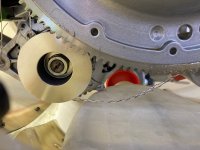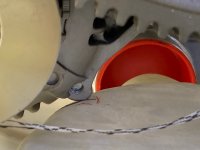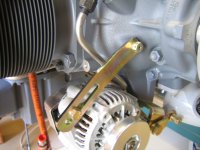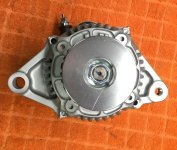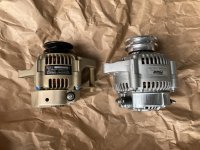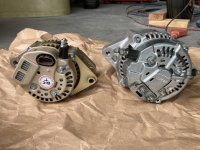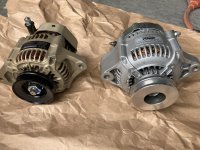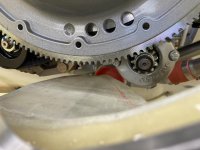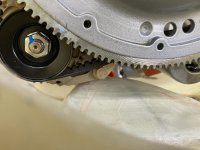OK, I’m about to step in it here. I’ve already reached out to someone I trust regarding such application so now I’m throwing it out to the world. Always worried about the alligator I don't see.
Background:
Electrically dependent aircraft
Dual battery, Alt and BU gen, redundant bus architecture.
Issue:
Had to raise top of airbox to allow straight alignment with TB inlet. A very short “S” turn of SCAT at those flow velocities is less than ideal to me.
Now there is interference between Alternator and airbox.
Question (simplified):
What size Alternator is “acceptable”?
Factors (slightly conservative):
9.13 amps = Full Avionics nominal load (no radio xmitting, AP actuators not cycling continuously, etc)
3 amps = Conservative Alt field load
1,2 amps – total relay draw
7 amps = FI/EI load
10 amps ~ pitot heat load
8 amp ~ luxury load/not required for heated seats
So
20.3 amps to fly the aircraft without shedding anything (assuming no scope creep)
30.3 if pitot heat is required
38.3 if seat heaters are on (installation is not a must have)
Would 40 amp primary alt be “safe”/manageable in an off-nominal situation? The slightly smaller diameter will definitely help.
The old 80% capacity rule for alts seems a bit outdated in dual bus/battery/source configurations.
This isn’t about trying to save money or weight. I want a 60 amp alt but clearances are making this a bigtime challenge. Attached pix are NOT with the cowl fully in position. There will be more, additional fiberglass work as a minimum and possibly a custom alt boss bracket needed.
Thoughts are appreciated. I'd like to order one before the weekend
Background:
Electrically dependent aircraft
Dual battery, Alt and BU gen, redundant bus architecture.
Issue:
Had to raise top of airbox to allow straight alignment with TB inlet. A very short “S” turn of SCAT at those flow velocities is less than ideal to me.
Now there is interference between Alternator and airbox.
Question (simplified):
What size Alternator is “acceptable”?
Factors (slightly conservative):
9.13 amps = Full Avionics nominal load (no radio xmitting, AP actuators not cycling continuously, etc)
3 amps = Conservative Alt field load
1,2 amps – total relay draw
7 amps = FI/EI load
10 amps ~ pitot heat load
8 amp ~ luxury load/not required for heated seats
So
20.3 amps to fly the aircraft without shedding anything (assuming no scope creep)
30.3 if pitot heat is required
38.3 if seat heaters are on (installation is not a must have)
Would 40 amp primary alt be “safe”/manageable in an off-nominal situation? The slightly smaller diameter will definitely help.
The old 80% capacity rule for alts seems a bit outdated in dual bus/battery/source configurations.
This isn’t about trying to save money or weight. I want a 60 amp alt but clearances are making this a bigtime challenge. Attached pix are NOT with the cowl fully in position. There will be more, additional fiberglass work as a minimum and possibly a custom alt boss bracket needed.
Thoughts are appreciated. I'd like to order one before the weekend



